
| Publisher: | Knopf | |
| Genre: | Political, Fiction, Sagas, Literary | |
| ISBN: | 9780307700285 | |
| Pub Date: | October 2012 | |
| Price: | $26.95 |
| Starred | Fiction |
by Orhan Pamuk, trans. by Robert Finn
The politics of late 1970s Turkey are deafening in Silent House, Orhan Pamuk's second novel--originally published in 1983 but only now available in an English-language translation. In a crumbling mansion, an old woman lives with only her memories and a dwarf she hates for company. She is joined by her grandchildren when they visit for the summer: Faruk, a middle-aged historian with a failed marriage and a stalled career; Nilgun, a pretty young woman with communist sympathies; and Metin, a teenager who aspires to strike it rich in America's corporate industry.
The drama begins, and escalates, when Nilgun rejects the advances of Hasan, her poorer, nationalist cousin. With the tensions that have been mounting in Turkey between the nationalists and the communists, what could have been merely a failed romance becomes a catalyst for violence and tragedy. In this regard, Silent House is similar to Pamuk's novel Snow--a slow building of political tensions, made more volatile by history, that ultimately explode in violence. The difference is that Silent House is narrower in focus, with the family serving as a microcosm for Turkish society.
While this novel at times feels raw in comparison to Pamuk's later works, readers with an interest in the complexities of the Middle East will gain vital insight into the tumultuous shaping of a country. --Ilana Teitelbaum, book reviewer at the Huffington Post
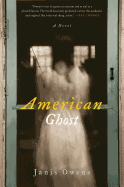
| Publisher: | Scribner | |
| Genre: | Gothic, Fiction, Cultural Heritage | |
| ISBN: | 9781451674637 | |
| Pub Date: | October 2012 | |
| Price: | $25 |
| Fiction |
by Janis Owens
Janis Owen takes inspiration from real-life events to tell the story of a fictional Florida town haunted by its past in the perceptive, well-paced American Ghost. In the 1930s, a white shop-owner in the panhandle community of Hendrix was shot and killed in a robbery by a black man, and a lynching followed. Decades later, Sam Lense, a Jewish graduate student in anthropology, comes to Hendrix to study the region's ethnic composition, including a group of close-knit townsfolk who are distrustful of outsiders.
While doing his research, Sam falls in love with Jolie Hoyt, the humble, sheltered daughter of a protective, old-school preacher. The intensity of the young couple's three-month affair is the talk of the town. Some believe Jolie enraptured with Sam because he is a "rich Jew," while others feel that Sam is using Jolie and her connections to the "useless old lynching" for his own gain. The mounting tension threatens the small community until Sam's work is dramatically cut short and the bond between the lovers is ultimately severed.
The novel then fast-forwards 12 years: Jolie and Sam, transformed for better and worse, are reunited when a black businessman arrives in Hendrix seeking answers to a past that affects him personally. Owens weaves complex narrative strands together in a captivating story abundant with historical context and characterizations that reflect the foibles of human nature. --Kathleen Gerard, blogger at Reading Between the Lines
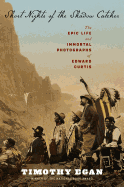
| Publisher: | Houghton Mifflin Harcourt | |
| Genre: | United States, General, Native American, History, Biography & Autobiography, Artists, Architects, Photographers, Adventurers & Explorers | |
| ISBN: | 9780618969029 | |
| Pub Date: | October 2012 | |
| Price: | $28 |
| Biography & Memoir |
by Timothy Egan
Timothy Egan's Short Nights of the Shadow Catcher, his biography of the photographer Edward Curtis (1868-1952), mesmerizes--it's instructive, entertaining and a joy to read.
In the late 19th century, Curtis had a successful photography studio in Seattle. The last surviving daughter of Si'ahl, the Native American chief who gave the city its name, lived there, too, and once Curtis found out about her, he took her picture. From then on, he became determined to find more Native Americans to photograph.
One day, he came across a lost hiking party on Mt. Rainier and led them to safety. One of the hikers was C. Hart Merriam, co-founder of the National Geographic Society, who invited Curtis to join him as the photographer on a voyage to Alaska. Curtis took 5,000 gorgeous photographs, many of Native Americans, using a laborious photogravure process in which the image was chemically etched onto the surface of a copper printing plate.
He now saw his life's work as photographing as many Native Americans as he could; thus was born the 20-volume The North American Indian. Although Curtis was criticized by some for "staging" his photos, he always wanted them to be as authentic as possible. When it was completed, his magnum opus compiled more than 1,500 photogravure plates of Indians from roughly 80 tribes. Yet fewer than 500 copies were printed, and complete, uncut sets are now worth millions.
The adjectives Egan uses in his subtitle--epic, immortal--set the bar high, but he clears it with ease. When it comes to historical writing, this is as good as it gets. --Tom Lavoie, former publisher
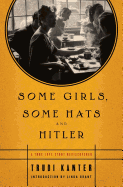
| Publisher: | Scribner | |
| Genre: | General, Biography & Autobiography, Women, Historical, Personal Memoirs | |
| ISBN: | 9781451688306 | |
| Pub Date: | October 2012 | |
| Price: | $24 |
| Biography & Memoir |
by Trudi Kanter
The path Trudi Kanter's memoir took to publication is almost as remarkable as the book itself. In 1984, Kanter self-published her tale of escaping the Nazis, but it soon went out of print. More than a quarter-century later, a British editor discovered a copy in a secondhand bookshop, and Some Girls, Some Hats and Hitler was rescued from oblivion.
Kanter (who died in 1992) wrote in the present tense, imparting a sense of optimism even though, as an Austrian Jew in 1938, she was effectively doomed. A talented, chic milliner, she created hats that were prized by fashionable Viennese women. Her passionate love for the dashing Walter Ehrlich kept her in Vienna after Hitler invaded, in part because he resisted acknowledging the danger. Kanter captures the fears of the time, but writes with equal detail of their love, her loyal customers and her hopes. Through her connections and cleverness in working diplomatic and legal angles, she and Ehrlich escaped to London in the summer of 1938, where the British briefly interned Walter (along with Kanter's father) and the family suffered through the Blitz. After the war, the couple became naturalized British citizens and prospered in their careers--Kanter eventually held a co-directorship of a hat company.
Some Girls, Some Hats and Hitler does not minimize the horrors of war or the Holocaust, but through Kanter's delightful hopefulness and spare, riveting writing, it presents an unusual memoir of an era that must not be forgotten. --Cheryl Krocker McKeon, bookseller

| Publisher: | Granta | |
| Genre: | Biography & Autobiography, Literary, Personal Memoirs | |
| ISBN: | 9781847084262 | |
| Pub Date: | October 2012 | |
| Price: | $13.95 |
| Biography & Memoir |
by Diana Athill
Diana Athill was born in 1917, assisted André Deutsch in establishing his British publishing firm and worked as an editor with some of the most important writers of the 20th century. In other memoirs, she has written about her career, her love life and friendships; in Yesterday Morning, she recalls her childhood in Norfolk.
Her childhood was replete with pony rides, indoor and outdoor games, chores and rather desultory schooling during visits to or long stays at the House, Diana's grandparents' stately home. "The most important thing about the place, for us children, was its feeling of permanence," Athill writes. "We did not feel deprived of entertainment.... We got our kicks from what was at hand: reading, riding, picnics, swimming in the icy North Sea, dances, acting in our own plays."
Athill recounts her parents' marriage becoming unhappy and the rows that gave her stomachaches, her mother's affair, the parade of nannies and the everydayness of a child's life when she is privileged and cosseted but still given the freedom to discover what is important to her.
Yesterday Morning is conversational, intimate and explanatory without being cloying. At 94, Athill says, "something I like about old age is that you can so easily let your mind drift. The present no longer contains much that demands concentrated thought: no more love affairs, no more work excitements or problems, no more (or very little) planning of entertainment or travel.... What an old person is... is a mobile reservoir of experience." We are lucky indeed to be able to draw from that reservoir. --Valerie Ryan, Cannon Beach Book Co., Ore.
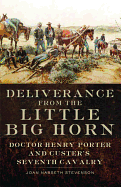
| Publisher: | University of Oklahoma Press | |
| Genre: | United States, General, State & Local - West, Native American, 19th Century, History, Biography & Autobiography, Medical, Military | |
| ISBN: | 9780806142661 | |
| Pub Date: | October 2012 | |
| Price: | $24.95 |
| History |
by Joan Nabseth Stevenson
While General George Armstrong Custer was facing his last battle against the Sioux, another engagement was being fought on the steep bluffs and hilltop above the Little Big Horn River. Dr. Henry Porter was assigned to that battalion, and it is his compelling story Joan Stevenson brings to life in Deliverance from the Little Big Horn. Stevenson's extensive research is evident in the detailed description of the conditions under which the Seventh Cavalry fought that day: pounded by constant gunfire and a scorching sun, suffering from severe dehydration, the soldiers fought for two days--never realizing Custer and his men lay dead and exposed just four miles away.
With surprise and trepidation, Porter watched the smoke cloud raised by the departing Indians, a sign that the siege was over. Using litters and mules, the doctor and the army conveyed more than 50 wounded soldiers to a steamship for a harrowing 70-mile river journey to Fort Lincoln, where they could receive proper treatment. After the battle, Stevenson's comprehensive account covers the investigations into the mistakes made during the battles, portraying the bungled court appearances with sensitivity. The vivid prose leaves nothing to the imagination, and readers with delicate sensitivities may flinch at the gruesome descriptions of field amputations and soldiers dying in the field--even before the account of finding the corpses of Custer and his regiment--but the thoroughness of these scenes only enhances the reliability of Stevenson's historical work. --Lee E. Cart, freelance writer and book reviewer

| Publisher: | Experiment | |
| Genre: | Sports & Recreation, Track & Field, Running & Jogging | |
| ISBN: | 9781615190638 | |
| Pub Date: | October 2012 | |
| Price: | $23.95 |
| Sports |
by Ed Ayres
Ed Ayres has been running competitively for more than half a century. On a professional basis, he's also studied climate change, sustainability and a variety of issues facing the future of the human race and our planet. The Longest Race is the story of his 2001 run at the JFK 50 Mile, the United States' oldest ultramarathon. As Ayres attempts, at age 60, to set a new age-group course record, he contemplates the relationship of human endurance to the sustainability of human life in a fast-changing world.
Ayres's recollections a decade later are heavy on metaphor. The ultramarathon is a symbol not just for his life, but for any man or woman's life, and ultimately for the lifespan of humanity. The attributes that work toward sustainability at an individual level are equally valuable in a large society, Ayres says, and today's "sprint culture" would do well to reconsider the concept of pacing. He also touches on the atom bomb, human evolution, the U.S. crisis in physical fitness and the reasons for following a vegetarian diet. But for all its peripatetic allegory, The Longest Race is always the story of one epic 50-mile race in all its technical and visceral elements, and also a celebration of the sport of running and of our ability to keep running in changing times. For those readers inspired by his story, the appendix offers practical advice to the aspiring ultrarunner. --Julia Jenkins, librarian and blogger at Pages of Julia

| Publisher: | Algonquin | |
| Genre: | Pets, General, Biography & Autobiography, Dogs, Personal Memoirs | |
| ISBN: | 9781616200459 | |
| Pub Date: | October 2012 | |
| Price: | $23.95 |
| Pets |
by Steven Wolf, Lynette Padwa
Warning: Comet's Tale may cause spontaneous cases of greyhound adoption.
Some people dream of retiring before 50, but Steven Wolf found himself forced into retirement in his early 40s due to spinal degeneration. Wracked with pain and having to move to Arizona during the winter to escape the cold of Nebraska, where his wife and daughters remained, Wolf found companionship in an unexpected form: Comet, a retired racing greyhound who decided to adopt Wolf rather than the other way around. In Comet's dignified, gracious presence, Wolf finds temporary solace, but his health continues to degrade until getting out of bed or opening a door become monumental tasks. When his friends and health workers suggested Wolf get a service canine, he rejected the idea until his massage therapist asked, "What about Comet?"
Inquiries to professional trainers met responses that varied from polite refusals to outright laughter. After all, greyhounds are known for one thing: speed, not brains. However, Wolf had already learned from experience that some greyhounds are highly intelligent. Determined to prove the world wrong, he set out to train Comet himself, a journey that would bond the pair irrevocably and ultimately lead to a reversal of fate.
Although every bit a top-notch dog story, Comet's Tale is at heart an inspiring look into a man's struggle to remain himself in the face of a progressive disability. Wolf's admission of his own flaws and mistakes is as courageous and endearing as his fight to maintain independence, making the incredible ending both startling and welcome. --Jaclyn Fulwood, blogger, Infinite Reads
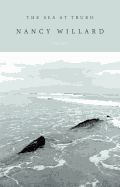
| Publisher: | Knopf | |
| Genre: | General, American, Poetry | |
| ISBN: | 9780307959775 | |
| Pub Date: | October 2012 | |
| Price: | $26 |
| Starred | Poetry |
by Nancy Willard
"Poetry lifts the veil from the hidden beauty of the world," Percy Bysshe Shelley once wrote, "and makes familiar objects be as if they were not familiar." This sentiment comes to mind when reading Nancy Willard. The Sea at Truro, Willard's 12th collection of poems, showcases her talent both for revealing the simple beauty in everyday life and for celebrating the people, the plants and the natural world that surround us.
Divided into five distinct parts, the poems in The Sea at Truro range in topic from the seemingly ordinary (a glass goblet, a tangerine, a bumblebee) to the more extraordinary (death and dying, grief and the afterlife, the worrisome state of our planet). Regardless of the subject matter, Willard's poetry is direct, often inquisitive and almost always notable for its striking imagery. Consider these lines from "Raphael's Goblet":
this tall, thin-lipped cup
as milky in the making
as if it held fog, or a veil
of smoke from its days
and nights in the fire,
a finger bone from a star.
Or, from the book's title poem:
long ropes of sand ridged like muscles
on the sea's floor, seeded with
ghostly pebbles polished like eggs
waiting in weedy nests.
The Sea at Truro will speak to many readers, whether or not they've read Willard's work. And most will not be able to resist revisiting a poem or two again in the future. --Roni K. Devlin, owner, Literary Life Bookstore
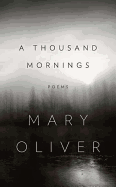
| Publisher: | Penguin Press | |
| Genre: | General, Poetry | |
| ISBN: | 9781594204777 | |
| Pub Date: | October 2012 | |
| Price: | $24.95 |
| Poetry |
by Mary Oliver
If you're one of the many, many fans of National Book Award- and Pulitzer-winning poet Mary Oliver, you'll very much welcome A Thousand Mornings.
One can't help but share in Oliver's love and enthusiam for life and the world around us, for "songs the shepherds sing, on the/ lonely mountains. while the sheep / are honoring the grass, by eating it." In one of the best poems in the book, "Tides," a single sentence running five stanzas explores what the "blue gray green lavender" low sea has left behind, from the "harbor's / dark-colored undercoat / slick and rutted and worm-riddled," to "barnacle-studded stones dragging / the shining sheets forward, deepening, / pushing, wreathing together / wave and seaweed, / their piled curvatures / spilling over themselves." When this description is complete, she adds:
"And here you may find me
on almost any morning
walking along the shore so
light-footed so casual."
So casual: Oliver's poetry seems that way on the surface, but look below and life rages, despite the hardness and disappointment the world can offer up. As she writes in "Lines Written in the Days of Growing Darkness":
"So let us go on, cheerfully enough,
this and every crisping day,
though the sun be swinging east,
and the ponds be cold and black,
and the sweets of the year be doomed."
A Thousand Mornings closes with a moving poem about Oliver's dog Percy that echoes Christopher Smart's famous poem to his cat Jeoffrey; dog lovers will shake their heads in a sad understanding and compassion: "For he was made small but brave of heart." --Tom Lavoie, former publisher

| Publisher: | Knopf | |
| Genre: | Jewish, Adolescence, Social Issues, Juvenile Fiction, Religious | |
| ISBN: | 9780375868610 | |
| Pub Date: | August 2012 | |
| Price: | $16.99 |
| Starred | Children's & Young Adult |
by Deborah Heiligman
Many young adult novels take a few chapters to slide you into the narrator's world. But by page three of Intentions, readers know Rachel's family is falling apart; by page six, she's overheard her beloved rabbi having sex on the bima. It's an appropriately sudden beginning for a novel that captures the rapid letdowns and occasional triumphs of adolescence with realism and compassion.
Rachel Greenberg, a 15-year-old living in Pennsylvania, is having a rough year. Not only are her parents fighting, but her best friend Alexis has turned into another person, her Grandma battles dementia, and Rachel likes Jake, but thinks Adam is hot. She begins to suspect there must be something wrong with her. Rachel always thought that Rabbi Cohn "might be the most perfect human being on the planet." When he turns out to be much less than that, Rachel has nowhere to turn in the wake of so many changes.
The real star of the book is Rachel's genuine, clear voice. She stumbles from one bad decision to the next, and then must face the consequences of each. It's painful to imagine any person going through so much on their own, and even more so because Heiligman (Charles and Emma) doesn't allow for tidy solutions. For teens, who will identify with this sort of chaos, this book can be just the friend they're looking for; for adults, it is a good reminder of that awkward journey of adolescence toward becoming the person one is meant to be. --Stephanie Anderson, readers' advisor at Darien Library and blogger

| Publisher: | Little, Brown | |
| Genre: | General, Social Issues, Juvenile Fiction, Monsters | |
| ISBN: | 9780316045476 | |
| Pub Date: | September 2012 | |
| Price: | $16.99 |
| Children's & Young Adult |
by Patrick McDonnell
Patrick McDonnell's (Me... Jane; The Gift of Nothing) enchanting monster tale will be relevant long past Halloween.
Grouch, Grump and two-headed Gloom 'n' Doom live in a dark castle under a black cloud and argue over which one is the biggest, baddest monster until they wind up in a brawl. "Their little monster heads were always filled with big monster thoughts." Then one day, they unite to make "the biggest, baddest monster EVER!" But when they unveil the green-hued giant, he doesn't roar a fearsome roar. He says, "Dank you!" and opens the window to let in the light as little terrors turn from the sun in horror. "No, no, no no, NO!!!" they cry. "You're supposed to be a MONSTER!" When their Frankenstein-like creation finally lets out a ROAR and crashes through a wall, the three believe they may have achieved success after all.
But like Mary Shelley's invention, the fellow has a mind of his own. The monsters' monster hits the bakery ("Dank you!" he says again) and heads for the beach. The vistas open up and the sky brightens as together the monsters watch the sun come up with a sense of awe and wonder. The frenetic pace and all capital letters of the early pages grow more serene as the monsters' creation casts a spell of calm and gratitude. The little terrors quickly realize they have no control over their creation, and he has a few things to teach them himself. --Jennifer M. Brown, children's editor, Shelf Awareness
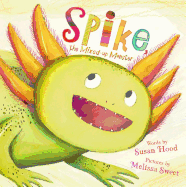
| Publisher: | Paula Wiseman/S&S | |
| Genre: | Animals, Reptiles & Amphibians, Social Issues, Juvenile Fiction, Humorous Stories, Emotions & Feelings | |
| ISBN: | 9781442406018 | |
| Pub Date: | September 2012 | |
| Price: | $16.99 |
| Children's & Young Adult |
by Susan Hood, illust. by Melissa Sweet
Sometimes kindness trumps scariness, when it comes to being an effective monster. That's the theme of Susan Hood's (Just Say Boo!) slyly engaging picture book.
"Spike was a monster. Or so he thought," the story begins, as Melissa Sweet (Balloons over Broadway) introduces a charming lime-green fellow with a baby-tooth smile and golden sunray-like spikes around his face. "Sí, I'm a monster all right!" says he. He practices swooshing his tail, shaking his spikes and baring his pointy teeth for hours. But Spike is small--"no bigger than a lily pad"--and can't seem to send his neighbors running in fright no matter how hard he tries. The animals around his pond call Spike "amigo," "adorable" and "my funny little fish face." Hood sprinkles Spanish words in just the right places, so children can figure out their meanings in context.
When a Gila monster slinks along the pond's edge, however, he sends the others running. All except Spike, who flaunts his monster moves, then grins at his performance. "Did I scare you?" asks Spike. It's directions, not courage, the Gila monster seeks, so Spike helps him on his way and earns hero status with the other pond creatures. "How did you tame the monster?" one asks. Spike just smiles. Photos in the back matter show how closely Sweet based her illustrations on the real animals, and a glossary translates the Spanish words. A charmer. --Jennifer M. Brown, children's editor, Shelf Awareness